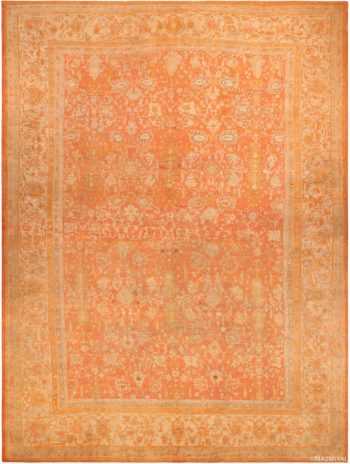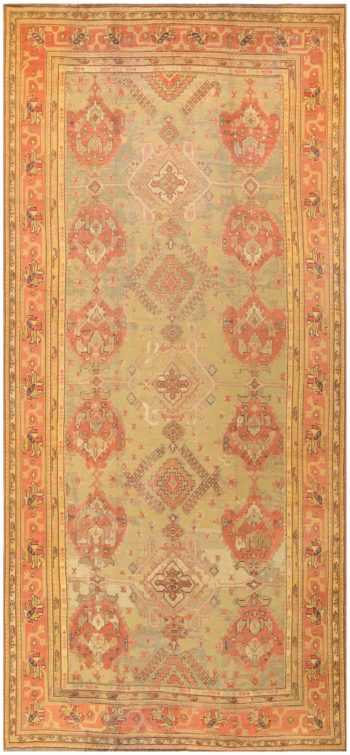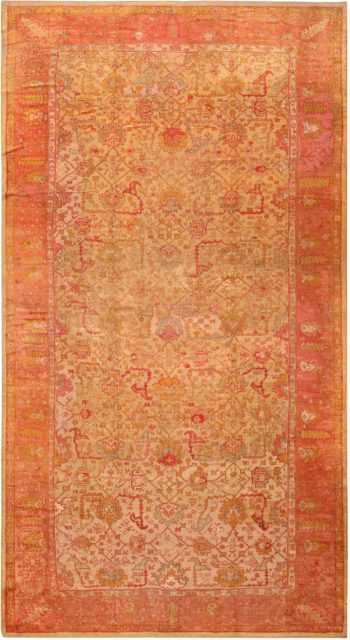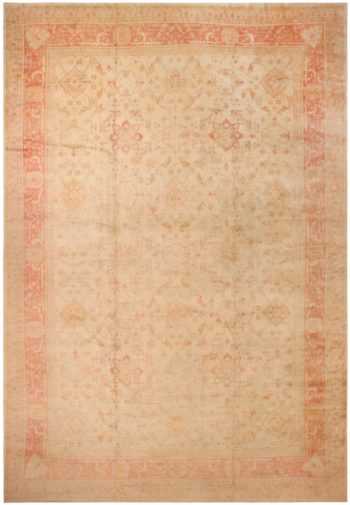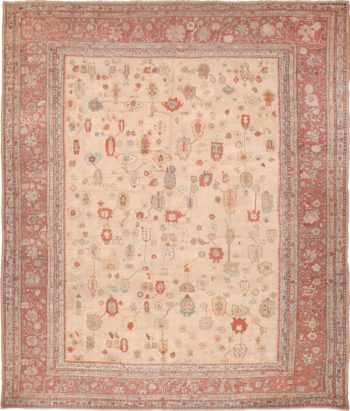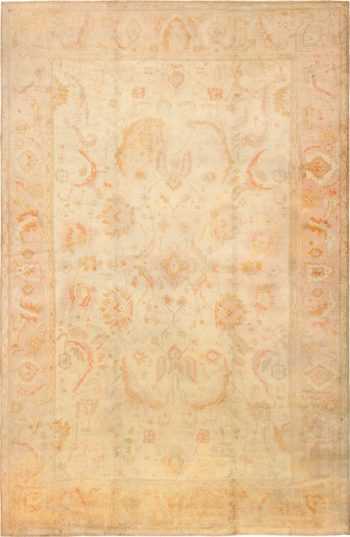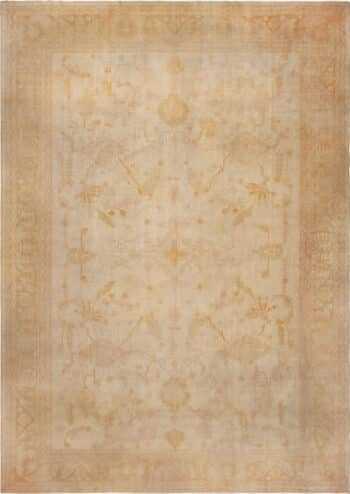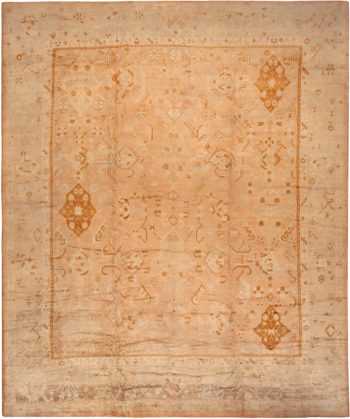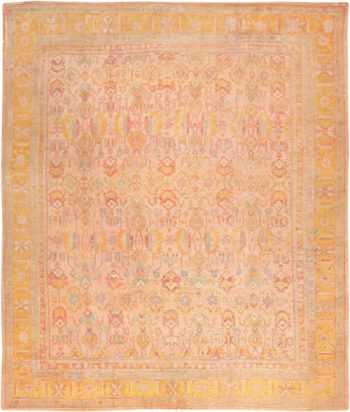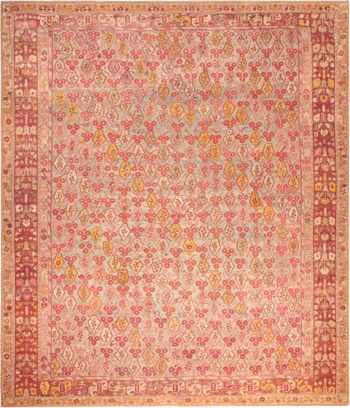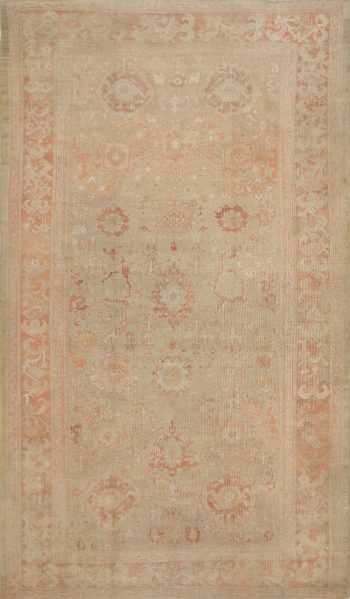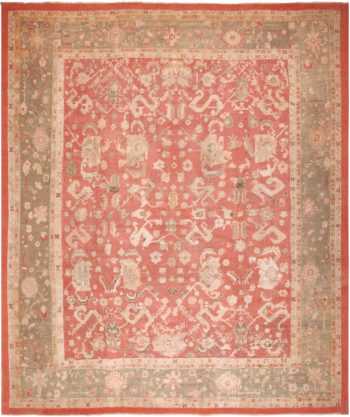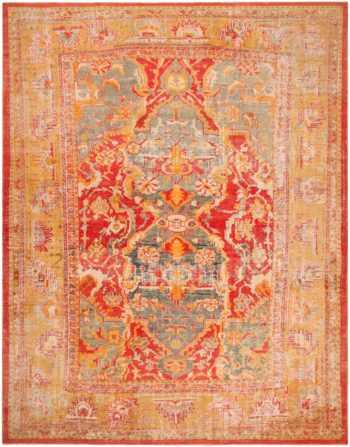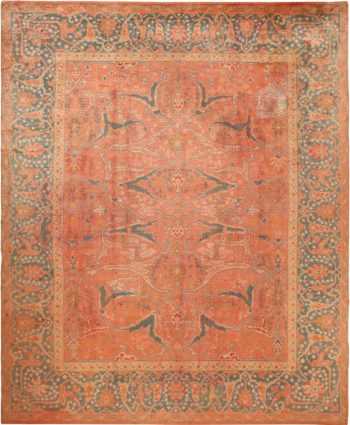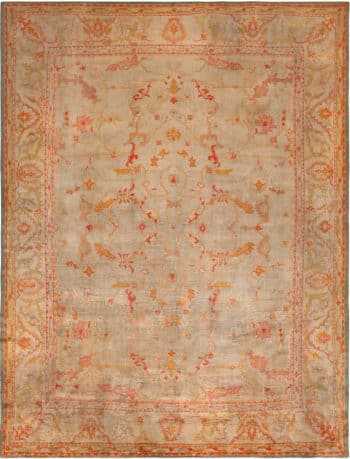Antique Oushak Rugs From Turkey
Discover Distinctive Charm Of Antique Turkish Oushak Rugs
View our current collection of Turkish antique Oushak rugs for sale below:
Oversized Decorative Antique Turkish Oushak Carpet 71632
$165,000.00Size: 20 ft x 26 ft 6 in (6.1 m x 8.08 m)Antique Oversized Turkish Oushak Rug 50239
$24,000.00Size: 11 ft 8 in x 25 ft (3.56 m x 7.62 m)Oversized Tribal Antique Turkish Oushak Shabby Chic Rug 50199
Size: 16 ft 3 in x 24 ft 7 in (4.95 m x 7.49 m)Oversized Antique Shabby Chic Turkish Oushak Rug 70877
Size: 12 ft x 22 ft 8 in (3.66 m x 6.91 m)Beautiful Warm Decorative Oversized Vintage Ivory Cream Turkish Oushak Allover Rug 71966
Size: 14 ft 8 in x 22 ft (4.47 m x 6.71 m)Antique 17th Century Turkish Smyrna Rug 70267
$125,000.00Size: 11 ft 8 in x 21 ft 3 in (3.56 m x 6.48 m)Large Rich Rustic Red Color Antique Allover Tribal Design Turkish Oushak Rug 71413
$88,000.00Size: 16 ft 4 in x 20 ft (4.98 m x 6.1 m)Large Ivory Background Tribal Antique Turkish Oushak Rug 49658
$76,000.00Size: 15 ft 10 in x 19 ft 7 in (4.83 m x 5.97 m)Large Oversized Cream Antique Decorative Turkish Oushak Rug 49166
Size: 12 ft 8 in x 19 ft 7 in (3.86 m x 5.97 m)Antique Geometric Turkish Oushak Rug 72847
Size: 13 ft 6 in x 18 ft 8 in (4.11 m x 5.69 m)Large Square Allover Tribal Design Antique Soft Seafoam Green Turkish Ghiordes Rug 71443
$125,000.00Size: 15 ft 6 in x 18 ft 7 in (4.72 m x 5.66 m)Large Pastel Antique Ivory Turkish Oushak Area Rug 48473
Size: 15 ft x 18 ft 6 in (4.57 m x 5.64 m)Large Soft Washed Out Antique Turkish Oushak Rug 71508
$42,000.00Size: 12 ft 6 in x 17 ft 10 in (3.81 m x 5.44 m)Decorative Large Antique Turkish Oushak Rug 70519
Size: 14 ft 10 in x 17 ft 7 in (4.52 m x 5.36 m)Large Soft Decorative Coral Color Antique Tribal Allover Design Turkish Oushak Rug 47427
$89,000.00Size: 14 ft 7 in x 17 ft 6 in (4.44 m x 5.33 m)Large Antique Turkish Ghiordes Area Rug 70394
$58,000.00Size: 15 ft 5 in x 17 ft 4 in (4.7 m x 5.28 m)Antique Turkish Oushak Rug With Arts and Crafts Design 49146
$38,000.00Size: 8 ft 4 in x 17 ft 3 in (2.54 m x 5.26 m)Soft Decorative Large Scale Allover Design Antique Rustic Turkish Oushak Carpet 71268
$69,000.00Size: 10 ft 3 in x 17 ft 3 in (3.12 m x 5.26 m)Large Tribal Antique Turkish Oushak Rug 49907
$42,000.00Size: 13 ft 6 in x 16 ft 6 in (4.11 m x 5.03 m)Large Tribal Allover Design Soft Rustic Decorative Color Antique 19th Century Turkish Oushak Rug 70235
$69,000.00Size: 10 ft 8 in x 16 ft 4 in (3.25 m x 4.98 m)Soft Washed Out Faded Large Antique Turkish Oushak Rug 46694
$38,000.00Size: 13 ft 7 in x 16 ft 4 in (4.14 m x 4.98 m)Rustic Tribal Allover Design Large Size Antique Shabby Chic Turkish Ghiordes Rug 71453
$46,500.00Size: 12 ft 2 in x 16 ft 2 in (3.71 m x 4.93 m)Large Coral Antique Turkish Oushak Area Rug 70876
$39,500.00Size: 12 ft 9 in x 16 ft 2 in (3.89 m x 4.93 m)Beautiful Large Antique Decorative Turkish Oushak Rug 71940
$36,500.00Size: 12 ft x 15 ft 9 in (3.66 m x 4.8 m)
The Decorative Oushak Rugs From Turkey
What is an “Oushak Rug”?
An Oushak rug, also spelled Ushak or Uşak, is a type of handmade rug that originates from the town of Oushak in western Anatolia, Turkey. These rugs have a rich history and are highly regarded in the world of traditional rug weaving.
Here are some key characteristics and features of Oushak rugs:
- Geographical Origin: Oushak is a historic town in western Turkey with a tradition of rug weaving dating back centuries. The town has been a prominent center for rug production, and Oushak rugs are named after this region.
- Design Aesthetics: Oushak rugs are known for their distinctive design aesthetics. They often feature oversized geometric patterns, large-scale floral motifs, and central medallions. The designs are generally more spacious and open compared to the intricate floral patterns found in some other types of rugs.
- Color Palette: Oushak rugs are characterized by a unique and muted color palette. Earthy tones such as beige, ivory, soft gold, and pale blues are commonly used. The colors are typically subtle and harmonious, contributing to the rugs’ timeless and elegant appearance.
- Soft Wool: Oushak rugs are crafted from high-quality wool, known for its softness and lustrous sheen. The use of quality materials enhances the comfort and durability of these rugs, making them suitable for various settings.
- Vegetable Dyes: Traditional Oushak rugs often use natural or vegetable dyes in the coloring process. This contributes to the rugs’ soft and muted color palette while also appealing to those who prefer natural and eco-friendly materials.
- Antique and Vintage Varieties: Antique Oushak rugs, which can be several decades old or even centuries old, are highly sought after by collectors. These vintage pieces often carry historical and cultural significance, showcasing the artistry and craftsmanship of the time.
- Versatility: Oushak rugs are versatile and can complement a range of interior design styles. Whether placed in traditional, transitional, or contemporary settings, their timeless designs make them adaptable to various decor aesthetics.
- Cultural Heritage: Oushak rugs have a rich cultural heritage, reflecting the artistic traditions of Anatolian and Turkish weaving. The patterns and designs often carry historical and cultural significance, adding depth to these handwoven creations.
These area rugs have gained international acclaim for their beauty, craftsmanship, and unique design characteristics. They are often used as decorative elements in homes and are appreciated for their ability to add a touch of elegance to a space. Additionally, the historical and cultural significance associated with Oushak rugs makes them highly valued by collectors and enthusiasts of traditional textiles.
More about the Oushak rug
An Oushak rug, also spelled as “Ushak”, is a type of handmade rug that originates from the region of Oushak (Uşak) in western Turkey. This specific location has a rich history of rug weaving dating back centuries, and the rugs produced in this region are highly regarded for their exceptional quality and distinctive designs.
These iconic rugs are characterized by their unique color palette, which typically features soft, muted tones such as pale blues, ivory, soft gold, and terracotta. These colors are achieved through the use of natural dyes and vegetable-based pigments. The designs of these rugs from Turkey are often centered around a large, central medallion surrounded by floral motifs and geometric patterns. The motifs are typically stylized and abstract, with a graceful and elegant appearance.
One of the notable features of these carpets is their weave which is not as fine as other types of Turkish rugs. They are woven using the Turkish knot, also known as the Ghiordes knot, which creates a dense and durable pile. The wool used is of high quality and provides a soft and luxurious texture.
These specific rugs have gained popularity worldwide and are highly sought after for their timeless beauty and versatility. They are often used as decorative pieces in both traditional and contemporary interiors, adding warmth, texture, and a touch of Turkish artistry to any space.
What makes Oushak Rugs so special?
Oushak rugs, also spelled Ushak or Uşak, are a type of Turkish rug that originates from the town of “Oushak” in western Anatolia, Turkey.
These Oushak rugs have been produced for centuries and are highly regarded for several distinctive features that contribute to their special status:
- Unique Color Palette: These rugs are known for their unique and distinctive color palette. They often feature soft, muted colors such as beige, ivory, pale gold, and soft blues. These colors give the rugs a timeless and elegant appearance, making them well-suited for a variety of interior design styles.
- Oversized Geometric Designs: The rugs typically showcase oversized geometric designs, including large-scale floral motifs and medallions. The designs are often more relaxed and spacious compared to the intricate patterns found in some other types of rugs, creating a sense of openness and tranquility.
- Vegetable Dyes: The traditional carpets from Oushak are often dyed using natural or vegetable dyes. This not only results in a soft and harmonious color palette but also contributes to the rugs’ appeal for those who appreciate natural and eco-friendly materials.
- Soft and Lustrous Wool: These carpets are crafted from high-quality wool, which is known for its softness and lustrous sheen. The use of quality materials enhances the comfort and durability of these rugs, making them a desirable choice for both functional and aesthetic purposes.
- Antique and Vintage Appeal: The antique examples, which are several decades old or even centuries old, are particularly prized for their historical and cultural significance. They often carry a sense of craftsmanship and artistry that is highly valued by collectors and enthusiasts.
- Adaptability to Various Styles: These area rugs are versatile and can complement a wide range of interior design styles. Whether placed in traditional, transitional, or contemporary settings, these rugs have a timeless quality that allows them to blend seamlessly with diverse decor aesthetics.
- Cultural Heritage: These carpets have a rich cultural heritage, and their designs often reflect the artistic traditions of Anatolian and Turkish weaving. The historical significance and cultural depth associated with these rugs add to their allure.
- Investment Value: The best exmaples are often considered valuable investments. As with many handmade rugs, their value can appreciate over time, especially if they are well-preserved and in good condition.
Oushak rugs are special due to their unique color palette, oversized geometric designs, use of natural dyes, high-quality wool, adaptability to various styles, cultural heritage, and potential investment value. Collectors and individuals seeking a combination of aesthetic appeal and historical significance often appreciate the special qualities of the rugs.
Why do people buy “Oushak Rugs” specifically?
People choose to buy Oushak rugs for several reasons, and the popularity of these rugs can be attributed to a combination of unique features, cultural significance, and aesthetic appeal.
Here are some reasons why individuals may specifically seek out and buy Oushak rugs:
- Timeless Design: These area rugs are known for their timeless and classic designs. The oversized geometric patterns, large-scale floral motifs, and open layouts contribute to a sense of elegance that transcends specific design trends. This makes the rugs suitable for a wide range of interior styles.
- Distinctive Color Palette: The muted and harmonious color palette of these rugs, featuring soft earth tones and pastels, appeals to those who prefer subtle and sophisticated colors in their decor. The gentle hues contribute to a serene and inviting atmosphere.
- Softness and Quality Materials: The rugs are often crafted from high-quality wool, known for its softness and durability. The use of quality materials enhances the comfort underfoot, making these rugs desirable for both aesthetic and functional purposes.
- Cultural Heritage: These carpets carry a rich cultural heritage, reflecting the artistic traditions of Anatolian and Turkish weaving. Individuals with an appreciation for cultural history and traditional craftsmanship may be drawn to these area rugs as pieces that tell a story of centuries-old weaving traditions.
- Versatility: The versatile designs of these iconic Turkish made carpets make them adaptable to various interior design styles. Whether placed in a traditional setting, a contemporary space, or a transitional environment, these rugs can complement a wide range of decor aesthetics.
- Investment Value: The best examples of these magnificent carpets in particular, are often considered valuable investments. Collectors and enthusiasts may appreciate the historical and artistic value of these vintage pieces, and their rarity can contribute to their investment potential.
- Eco-Friendly Appeal: The original examples often use natural or vegetable dyes in the coloring process, appealing to those who prioritize environmentally friendly and sustainable materials in their homes.
- Artistic and Handmade Quality: The rugs are handmade, and the craftsmanship involved in their creation adds to their appeal. The attention to detail and the artistic skill of the weavers contribute to the uniqueness of each rug.
- Cohesive Interior Design: These carpets can serve as focal points in a room, tying together various elements of the decor. Their classic and adaptable designs make them effective in creating a cohesive and well-designed interior space.
Overall, people buy these rugs for their combination of aesthetic charm, cultural significance, quality craftsmanship, and the ability to enhance the atmosphere of a living space. Whether sought for their historical value, investment potential, or simply their visual appeal, these carpets have a lasting allure in the world of interior design.
How do people decorate around Oushak rugs?
Decorating around Oushak rugs involves considering the rug as a central element in your interior design and creating a cohesive and harmonious space.
Here are some tips on how to decorate around Oushak rugs:
- Select a Color Scheme: Use the colors present in the rug as a foundation for your overall color scheme. Consider coordinating wall colors, furniture upholstery, and other decor elements with the muted and harmonious hues of the rug. This helps create a cohesive and balanced look.
- Choose Complementary Furniture: Select furniture that complements the style and colors of the rug. Neutral-colored or solid furniture pieces can work well to balance the intricate patterns of the rug. If the rug features soft pastels or earth tones, consider incorporating furniture in similar tones.
- Layering with Textures: Incorporate different textures to add depth and interest to the room. The rugs often have a soft and lustrous texture, so consider pairing them with furniture, throw pillows, and accessories that have varying textures, such as woven fabrics, leather, or metallic accents.
- Mix Patterns Thoughtfully: If you have other patterns in the room, such as on throw pillows or upholstery, choose patterns that complement rather than compete with the area rug. Consider varying the scale of patterns to create visual interest without overwhelming the space.
- Define Areas with Furniture Arrangement: Use these beautiful carpets to define specific areas within a room. For example, in a living room, arrange the furniture in a way that the front legs are placed on the rug, creating a cohesive seating area. This helps anchor the furniture and provides a sense of purpose for the rug within the space.
- Add Art and Accessories: Choose artwork and accessories that enhance the overall design. Consider incorporating pieces that pick up on colors from the rug or complement its style. This could include framed artwork, decorative vases, or other accessories that contribute to the room’s aesthetic.
- Consider Lighting: Pay attention to lighting fixtures in the room. Choose lighting that complements the style of the rug, whether it’s modern, traditional, or eclectic. Well-chosen lighting can enhance the overall ambiance of the space and highlight the beauty of the rug.
- Use Oushak Rugs in Various Spaces: The Turkish Oushak rugs can be versatile and work well in various spaces, including living rooms, dining rooms, bedrooms, and even entryways. Consider the size and design of the rug to determine the most suitable placement within different areas of your home.
- Create a Focal Point: Allow the rug to serve as a focal point in the room. Arrange furniture in a way that draws attention to the rug, and use the rug as a starting point for building the overall design theme of the space.
By paying attention to color coordination, furniture arrangement, and overall design harmony, you can create a well-decorated space around an rug that highlights its beauty and contributes to a cohesive and inviting atmosphere.
Learn More About Antique Turkish Oushak Rugs
Antique Turkish Oushak rugs have been woven in Western Turkey since the beginning of the Ottoman period. Historians attributed to them many of the great masterpieces of early Turkish carpet weaving from the 15th to the 17th centuries. However, less is known about what happened to production there in the 18th and early 19th centuries.
When things became more clear toward 1900, the Oushak region re-emerges as a major center, this time for room-size decorative rugs. The older examples of these carpets are especially desirable today as highly decorative pieces. They come in central, or small allover medallion designs as well as scattered sprays of vine scroll and palmettes. They are notable for the grand, monumental scale of the designs, often a subdued palette in soft apricot and golden saffron tones whose pleasing qualities are enhanced by their particularly soft and lustrous wool.
“Cosmopolitan” and “sophisticated” are two words that aptly describe these captivating rugs. Although the Ghiordes knot and the quirky angular designs have a certain primitive air, the rugs from Turkey are exceptionally unique and attractive. Without compromising to appeal to Western consumers, weavers here managed to create one of the country’s most desirable rug styles. The angular arabesques and ornamental medallions are not dissimilar from Persian motifs but are executed in a more rectilinear manner and woven in a unique palette that includes bold Mediterranean-influenced colors and chic pastels.
Over time, these carpets have become the rugs of choice for many of the top interior decorators in the world today. Just open any copy of architectural digest and you will see these magnificent carpets adorn the floors of many bedrooms, family rooms and living room floors.
What makes Oushak rugs so desirable?
For the most part they are not high quality rugs but that is not what makes them so desirable. Since the knot count is considerably lower than the antique rugs made in Persia – antique Turkish rugs were woven with larger scale patterns. These carpets are also extremely desirable because of their colors – which are usually much lighter and “happier” in feel than rugs from other regions. So if you are looking for an antique or vintage rug with a large scale design and soft colors, theses should top your list.
When did rug weaving in Oushak begin?
It is generally believed that rug making in Anatolia began with the advent of the Seljuks in the 11th century. By the 15th century, rugs were being produced by factories and independent weavers in the environs of Oushak. The origins of of the rugs from Oushak must therefore be looked for between these two dates. The rugs of the 15th, 16th, and 17th centuries were widely acclaimed in Europe where they were appreciated and depicted in the paintings of many artists such as Lorenzo Lotto and Hans Holbein. During the 18th century the production of these carpets had deteriorated and became much more commercial.
Although the rugs are made using less complicated methods, they are extremely decorative in nature. Their larger scale patterns, along with their soft and decorative coloration, make these rugs extremely sought after by the trend-setters and taste-makers in the interior design trade.
When were earliest rugs woven in Oushak?
From a relatively early time, during the Ottoman period, the town of Oushak, in western Turkey, has been a major center of rug production. Many of the great masterpieces of early Turkish rug weaving from the 15th to the 17th centuries have been attributed to this center.
Oushak rug weaving after the 17th century
After the 17th century, however, the development of Oushak rug weaving is less well known. A number of very large palatial scale carpets of 18th century date have been attributed to Oushak, and also to the town of Smyrna further to the West on the coast of Turkey.
The great star and medallion carpets of the late 15th to 17th century were made there, and it is even possible that the various carpets of the so-called “Holbein” type of family were products of Oushak as well. To say the very least, Oushak has a major claim to a long and distinguished tradition of rug weaving which has continued right up into modern times.
The later rugs of Smyrna and Oushak
The later Oushak or Smyrna carpets tend to have elements derived from the medallion and Star Oushaks, but arranged as allover designs, and in a much coarser or robust weaving technique that corresponded to the large size of the carpets and their designs.
As far as we can tell, rugs of this sort continued to be woven into the 19th century although in far fewer numbers. This 18th and earlier 19th century development should be seen within the larger setting of Oriental rug production at this time, which was a period of decline, not in quality but in scale because of the falling off of the European market.
European taste had moved away from Oriental rugs in favor of local European productions. Examples of these European weaving companies are Aubusson, Savonnerie and Axminster which produced carpets in a native, classically derived, European style.
Against this background it would seem that the larger 18th, and early 19th century Oushak or Smyrna carpets, were made for affluent local Turkish consumption.
What makes Oushak rugs so decorative and sought after?
It is no surprise that theses rugs are sought after. Their bold and embellished designs are the definition of antique style. In soft wool and muted palates, they project a soulful grace that balances everything from mid-century modern decor to old fashioned elegance. These rugs originated in the western Turkish town of Oushak, or Ushak. Through the 15th to 16th centuries, Turkey was a hub of carpet craftsmanship.
But by the 1900’s, Oushak became the stand-out center with their decorative, room-sized masterpieces. Often crafted in subtle tones of apricot and saffron, these antique carpets are a favorite among designers for their versatility and particularly soft texture. What we love most about these Turkish carpets is how they capture primitive design in cosmopolitan style.
Persian motifs and angular arabesques project the soulfulness of history, but the overall affect is read as nothing short of sophistication. These are the sort of antique carpets that steal the spotlight in any room, complimenting changing design trends with their timeless style.
All this changed after the middle of the 19th century when Ushak, now Oushak, re-emerged as a major center of production in keeping with the larger revival of oriental rug production in Turkey and Persia at this time.
A large and expanding middle class in the Europe and the United States created a sudden new demand for antique Oriental rugs, and like the many other rug producing centers with a long history behind them at this time, Oushak quickly rose to meet it.
How did Oushak rug design evolve?
We might expect the weavers from the Oushak region at this time to have embarked on a major revival of their greatest hits from their heyday in the Ottoman period, with copies or adaptations of Star and Medallion design types and the like, but this is exactly what did not happen. Times had definitely changed, and Persia had initially taken the lead in the new production of rugs for the western market.
Consequently, it was the floral designs of Persian type, both in medallion and allover formats, that now commanded the market, and it was designs of this type that the Oushak weavers began to develop. And they adapted to this new demand for room size decorative carpets very quickly and in the most remarkable ways.
Carpets like these were competing with the Ziegler, Mahal or Sultanabad production in contemporary Persia. But their color sensibility is softer and more delicate in keeping with the lustrous silky wool that is the hallmark of the best of these carpets.
During the century and a half or so after 1700, when the European appetite for Oriental rugs had fallen off, the volume of workshop weaving in Oushak must have diminished considerably.
When did western demand for Oushak rugs come back?
When the Western appetite for Oriental carpets suddenly increased in the later 19th century, the number of weavers still active in Oushak itself could not have met this demand, so the town manufactures had to turn to the village weavers of the surrounding areas who had maintained a continuous weaving tradition for centuries.
Such village weavers had tended to produce smaller rugs with a strong tribal sensibility. They made rugs with bold geometric designs and rugged kinetic drawing, using large knots and all-wool foundations.
Clearly when these weavers became incorporated into the town Oushak industry, they carried over all of their tribal traditions and sensibilities into the new production of Persianizing large-scale decorative carpets.
It would not have been too difficult to fuse such tribal village traditions with the existing town Oushak industry that had continued from the somewhat earlier Ushak and Smyrna large-scale rug production. In this way the style and technique of the Oushaks of the later nineteenth and earlier twentieth centuries was born.
The tribal geometric approach to the designs of Oushak rugs
The feeling of these designs is so strongly geometrical that many observers may not even recognize the floral quality of the designs. This geometry comes out especially in the angularity of the vine-scrolls, some of which even become zig-zags.
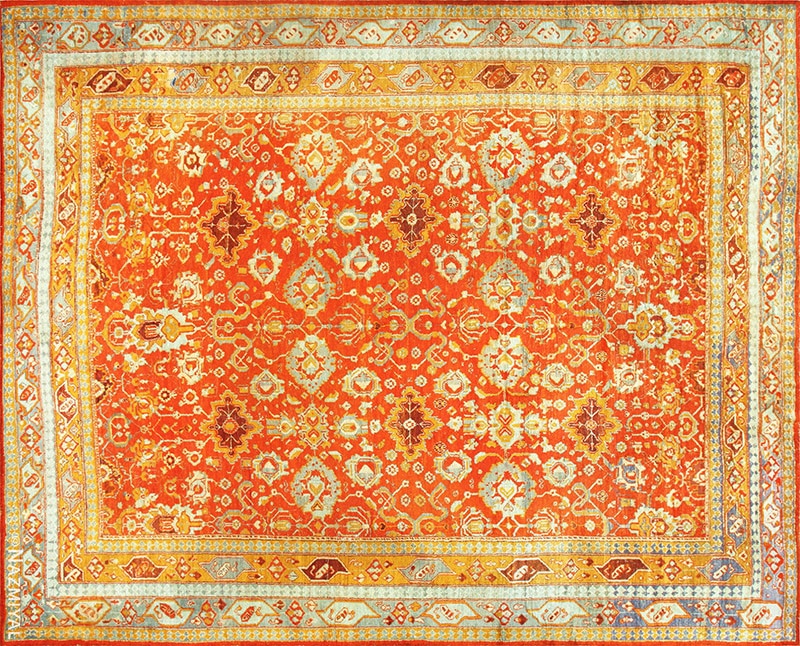
Antique Turkish Angora Oushak Rug
Despite the bold geometry and tribal sensibility that is so basic to room-size Oushaks from the decades around 1900, they nevertheless remain one of the most elegant types of room-size antique decorative rug or vintage rugs available in the current market.
The colors and soft texture of Oushak wool rugs
This is undoubtedly due to two factors – their coloration and their wool. The sweetness and warmth of the Oushak palette, relying as it does on soft terracotta’s, cinnamons, and golds, as well as delicate blues, grays, greens, saffron, and ivory, goes a long way to mollifying and balancing the honest strength of their designs. Similarly, the soft lustrous silken quality of the wool, especially in the so-called “Angora Oushaks,” endows these carpets with an incomparably tactile softness and gentility.
The appeal of Oushak rugs
Ultimately, the appeal of these carpets is the result of a marvelous balance of opposites – the contrast between monumental and delicacy, between boldness and subtlety, and between classical urban and village tribal design or taste. Only few antique carpets or vintage rug genres can pull off such a tour-de force. But the credit for this achievement goes not only to the Oushak weavers and designers themselves, but also to the complex circumstances behind the development of these carpets.
The earliest woven Turkish rugs
Although fragments of Turkish rugs from the ninth century CE have been found in Istanbul, they are rare and not well-preserved. It was not until the 13th century that substantial pieces of pile carpets survived. One such group, termed the Konya Rugs, was discovered in layers of antique carpets from within a mosque in central Anatolia. They date to the time of the Seljuks (11th to 14th centuries) and illustrate the fine coloration, weaving and pattern designs for which the Seljuks are so well known.
The design configuration of Oushak carpets
Motifs are stylized renderings of flowers, tendrils and leaves as well as geometric patterns.
Kufic designs, stylized Arabic script are seen on borders of carpets from not only this period, but throughout the continuum of carpet production after the advent of Islam.
These Turkish make carpets are often very large sized for architecture that we see around this time period in the Middle East. The medallions resemble designs used on Ottoman manuscript covers. Scholars attribute the Persian rendering of some of these forms to Tabriz artisans who were taken to Istanbul in the 1470’s. Prayer rugs were also important that we see in these carpets. Several fine examples illustrate the characteristic ornamentation and color common to Ottoman-period carpets.
The history of Oushak rugs
The history of the Turkish Oushak rugs and carpets is unique and it is riddled with the kind of fascinating historical developments and apparent coincidences of destiny that make up the most fascinating stories. The art of fine rug weaving has been an integral part of the culture and history of the Anatolian peninsula for millennia. Throughout the lands that comprise the present-day nation state of Turkey, rugs have been woven by master weavers over the course of the centuries. As one ruling dynasty gave way to the next, the rug weaving tradition continued uninterrupted. Many of the surviving 15th century carpets, that are still intact, can be attributed to Oushak weavers.
Over the long centuries that the Turkish people have been practicing this craft, Turkish weavers have been responsible for developing multiple styles and techniques of weaving rugs. They also developed a large array of traditional patterns that are found in antique rugs from all across the Oriental world, even to this day.
What is the most famous type of Turkish rug?
Perhaps one of the most famous – and certainly one of the most significant style of Turkish rugs is that which was developed in the western Turkish town of Oushak. Beginning in the early years of Ottoman rule, around the turn of the 13th century, the town of Oushak became an important center of Turkish rug production.
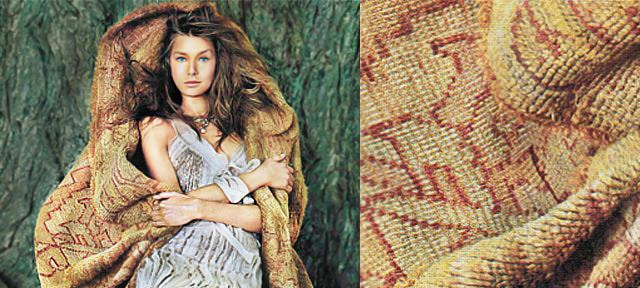
The Beauty Of Oushak Rugs – Model Wrapped In An Oushak Rug
Western demands for the exotic Oushak and Eastern rugs
Many depictions of antique Eastern rugs in old Western paintings seem to be of the styles designed and woven in Oushak. This small kernel of information is actually rather consequential since the European attitudes toward Oriental rugs would actually play an important factor in the history of the craft. In the late middle ages, for instance, it is notable that Oriental carpets – and, the historical record indicates, these carpets in particular – were rather in vogue. European lords were keen to own these exotic treasures, which were perceived as status symbols and a sign of wealth and discerning taste.
With great demand coming from Europe as well as within Turkey, the production of these rugs became an important commercial enterprise. However, by the 17th century, European tastes had changed. Rather than preferring the exotic appearing carpets of the Orient, wealthy Europeans began to purchase rugs that were designed and woven in Europe. Especially central to this development was the introduction of the Aubusson rugs and Savonnerie carpets from France.
The Ottoman empire’s demand fuels to rug production in Oushak
The French rugs featured richly decorated and ornate patterns that were more in line with traditional European aesthetic preferences. This development is quite notable as it indicates that the production of Oushak carpets at this time (the late 18th through the middle of the 19th centuries) was largely centered on orders that were coming predominantly from within the Ottoman Empire itself.
Naturally, this had an influence on the style of rugs that were being produced in Oushak. The Turkish customers generally preferred more traditional and less ostentatious carpets than those favored by their European neighbors. This remained the status quo for more or less a hundred years, until the middle years of the nineteenth century when everything began to change yet again. During this time period, Europe and the United States had begun the first stages of industrialization. With this new world social order, a middle class began to emerge for the first time. Also, tastes began to shift and suddenly a renewed interest in exotic furnishings from the orient began to take hold.
Worldwide spike in demand for Oriental rugs and carpets from turkey
By the late 19th century, the demand for Oriental carpets was higher than it has ever been. Workshops across Persia and Turkey began producing carpets on a much grander scale than they had before. They were weaving exciting pieces featuring new designs aimed at appealing to the sensibilities of the huge volume of these new Western consumers. In the town of Oushak, in particular, the weavers begun to take note of the designs that were being produced by their Persian counterparts. The antique Persian rugs mostly featured floral motifs that were hugely successful with Western audiences.
This market savvy approach, combined with an ancient weaving tradition, made Oushak an especially important center for rug production during this time. This legacy of rug production in Oushak is quite apparent in the exemplary carpets from this period that grace many homes across the world.
Oushak weavers adopt the more floral motifs of Persian rugs to meet stylistic demands
Perhaps the single most intriguing development of this boom in demand is the way it influenced the designs of the carpets. In addition to adopting the more floral motifs of Persian rugs, that were so popular with Western consumers, the Turkish weavers who created these magnificent pieces altered their style in a less direct way. They began to bring village weavers into the urban manufactories.
Because the demand for these Turkish carpets had grown so immensely and so quickly, there simply weren’t enough classically trained Turkish weavers to satisfy it. As such, those who wove in traditional ways with traditional methods were brought on to relieve some of the burden on the master weavers. Naturally, because of their background in traditional village weaving, these village rug weavers produced carpets that were less refined and more tribal and nomadic than those that had come before.
Bold geometric large scale designs were woven into these rugs and the knotting was larger than in other pieces. Whether a happy accident, or the as a result of an ingenious master plan, the end result of this process was a new and immediately recognizable style of rugs. Floral and tribal, understated and visceral, these carpets represented a unique coming together of a variety of tastes, and a variety of large-scale historical and cultural developments.
A millennia old craft that held a special status to the Turkish people, the weaving of these area rugs became important worldwide. This is due to the fact that the demand was so high and sought after. Oushak carpets have most certainly left their mark on the interior design and decorating trends all over the world.
Everything You Want to Know About Antique Carpets From Turkey
Also, feel free to also look up our Photo Gallery With Pictures Of Antique Turkish Oushak Rugs

